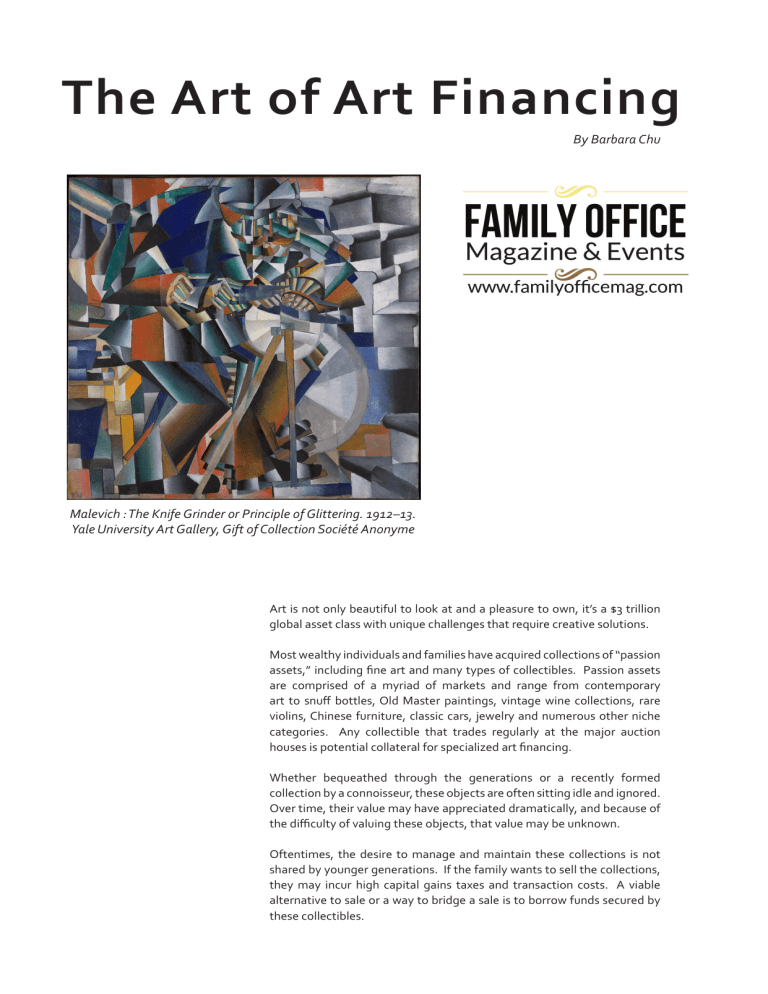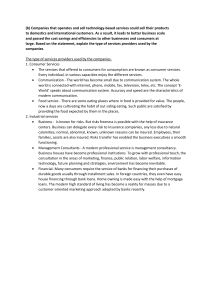
The Art of Art Financing By Barbara Chu Malevich : The Knife Grinder or Principle of Glittering. 1912–13. Yale University Art Gallery, Gift of Collection Société Anonyme Art is not only beautiful to look at and a pleasure to own, it’s a $3 trillion global asset class with unique challenges that require creative solutions. Most wealthy individuals and families have acquired collections of “passion assets,” including fine art and many types of collectibles. Passion assets are comprised of a myriad of markets and range from contemporary art to snuff bottles, Old Master paintings, vintage wine collections, rare violins, Chinese furniture, classic cars, jewelry and numerous other niche categories. Any collectible that trades regularly at the major auction houses is potential collateral for specialized art financing. Whether bequeathed through the generations or a recently formed collection by a connoisseur, these objects are often sitting idle and ignored. Over time, their value may have appreciated dramatically, and because of the difficulty of valuing these objects, that value may be unknown. Oftentimes, the desire to manage and maintain these collections is not shared by younger generations. If the family wants to sell the collections, they may incur high capital gains taxes and transaction costs. A viable alternative to sale or a way to bridge a sale is to borrow funds secured by these collectibles. Take, for example, a family office responsible for evaluating and maximizing multigenerational holdings of energy, agricultural, and business investments, as well as some physical assets. Among these is a museum-quality art collection purchased by earlier generations that is owned in a family foundation. While it is beautiful, the collection generates no income to support the foundation’s mission. It is a burden rather than a resource. By unlocking the value with a loan facility, the family office was able to create additional liquidity to invest for income and capital appreciation while the collection remained housed in a major museum. The facility was structured in such a way as to provide maximum flexibility for differing investment horizons, while giving the family office enough “dry powder” for opportunistic investments. It has a ten-year term that allows for long-term multigenerational investing objectives and is secured by art collateral, which supports this time period. The loan also provides a line of credit to pay debt service. For the family, the collection has become a source of liquidity while remaining a significant asset whose value can be harnessed to work for the family’s future growth. Art financing can also be used to generate funds to supplement income by structuring it as a series of payments. Typically, these loans will be longer term, with interest accruing until maturity. Fine wine, an asset whose value often lies underground and in storage, is an ideal category for financing. Many owners may be laying down vintages for future investment, separate from those that are for consumption. These collections may be ideal collateral for loan facilities structured with a line of credit to pay debt service. There are three categories of lenders that provide art financing: auction houses, boutique finance companies, and private banks. The major auction houses provide loans, as well as consignment financing and guarantees. These are typically short-term (three years) and will be repaid from the sales proceeds when secured by objects for sale. Often, the sales commissions are used as a way to subsidize the cost of the loan. These facilities are ideal for owners who wish to bridge items that will definitely be sold and for shorter term loans. London has several specialty art lending groups that provide art financing. Because of their source of funds (hedge funds, private equity), their loans are generally more expensive, but these boutique financiers will look at collateral and borrowers with a less conventional profile than the private banks. Major US banks will provide competitive art financing to their private clients. Some will offer this service to overseas clients, whereas others will not. In the UK, most private banks are only willing to do this type of loan in conjunction with more conventional collateral, such as real estate. The private bank model typically requires the owner to be an existing private client with substantial financial assets under management. Since these art loans have the right of “offset,” the bank has the right to sell financial assets to repay a defaulted art loan. In reality, this is an expensive form of securities backed lending. Our firm, Emigrant Bank Fine Art Finance, is part of Emigrant Bank (founded 1850), one of the largest privately owned banks in the US. Emigrant is FDIC insured and fully regulated by the banking authorities. Owned by the Milstein family, Emigrant provides competitively priced art loans to clients worldwide based on the collateral and credit quality and does not require borrowers to have assets under management. Emigrant Bank Fine Art Finance’s approach enables us to look at a wider range of collectible categories and to structure bespoke solutions for clients. Emigrant makes loans from US $3MM upwards, with tenures of 3 to 15 years. Loan facilities may be term loans, revolving lines of credit and combinations thereof. Lines of credit may often be used to pay debt service. All loans are denominated in U.S. dollars and are recourse to the principal. Emigrant requires possession in most locations except in the US. Barbara Chu is partner at Emigrant Bank Fine Art Finance. Tel +1-212-850-4500 ChuB@emigrantbankfineart.com



